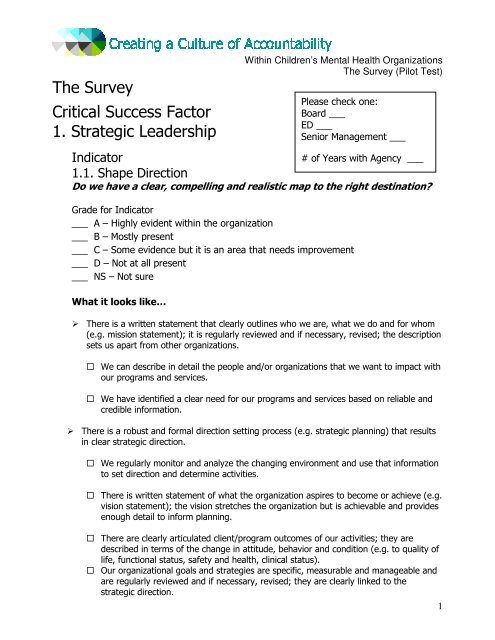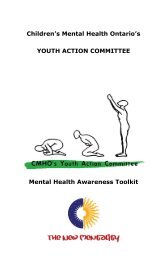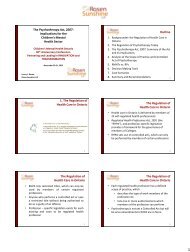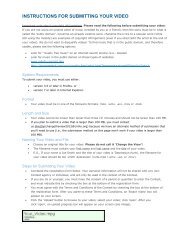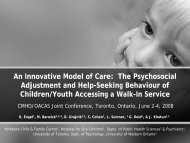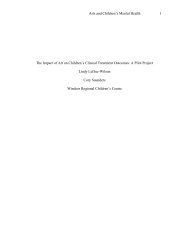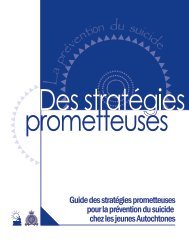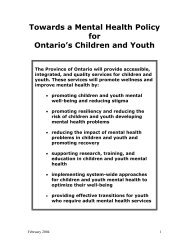Accountability Assessment Tool - Children's Mental Health Ontario
Accountability Assessment Tool - Children's Mental Health Ontario
Accountability Assessment Tool - Children's Mental Health Ontario
You also want an ePaper? Increase the reach of your titles
YUMPU automatically turns print PDFs into web optimized ePapers that Google loves.
WOLF - Technika Grzewcza Sp. z o.o. - Dokumentacja do celów uzyskania dotacji dosyst. solarnego. Opracowanie - Andrzej Karpinski.GetSolar Professional 10.1.1 - Bilans energetyczny symulacji -Projekt: 2xCRK_s_zielona_gora_str3_atmosf (5)Lokalizacja: Zielona Góra szer. geogr.: 51,9°Kolektor: 3,98 m 2 (2 Szt.) Wolf CRK-12Charakterystyka: eta0 = 0,642 a1 = 0,885 W/(m 2. K) a2 = 0,0010 W/(m 2. K 2 ) [Solar Keymark]Pochyłość: 45,0° Azymut: 0,0°Typ instalacji: Zasobnik solarny ciepłej wody uŜytkowejZasobnik:300 litrówmax. 85°C / min. 45°CZapotrzeb. ciepła: 13,08 kWh/dzień = 225 litrów/dzień z 10°C na 60°CMiesiąc Zysk Napro- Energia Stopień Sprawsolarnymieniow. konwen. Pokrycia ność[kWh] [kWh] [kWh] [%] [%]Styczeń: 52 110 366 12 47Luty: 93 195 303 24 48Marzec: 161 343 265 38 47Kwiecień: 202 436 214 49 46Maj: 290 630 146 67 46Czerwiec: 270 585 147 64 46Lipiec: 272 582 160 63 47Sierpień: 288 611 145 66 47Wrzesień: 198 410 217 48 48Październik: 133 270 290 31 49Listopad: 76 152 328 19 50Grudzień: 41 85 365 10 48Suma: 2077 4409 2946 41 47Przeciętny roczny zysk kolektora: 522 kWh/m2100%80%SprawnośćStopień pokryciac.w.u.60%40%20%Sty Lut Mar Kwi Maj Cze Lip Sie Wrz Paź Lis Gru Przekrój rocznyGetSolar © 2009 Axel Horn 07.10.2010 09:11:26 - Strona 2
Human Resources:Within Children’s <strong>Mental</strong> <strong>Health</strong> OrganizationsThe Survey (Pilot Test) There is a formal process to review the performance of the Board as a whole as well asindividual Board members based on clear and well understood expectations. We measure the performance of all staff through regular performance reviews as well asthrough other formal and informal feedback throughout the year; the review is clearly tiedto strategic and annual goals. There is a formal process to evaluate the performance of key non-governing volunteersbased on clear goals and expectations. We measure the performance of committee’s, task forces, etc. against clear outcomes andexpectations on at least an annual basis.Why did you give it the grade?6
Critical Success Factor2. Performance CultureWithin Children’s <strong>Mental</strong> <strong>Health</strong> OrganizationsThe Survey (Pilot Test)Indicator2.1 Generate reliable information about performanceGrade for Indicator___ A – Highly evident within the organization___ B – Mostly present___ C – Some evidence but it is an area that needs improvement___ D – Not at all present___ NS – Not sureWhat it looks like…General: There is a short list of closely watched performance indicators that alert us to issues. We balance the cost of collection of our information with its usefulness.Why did you give it the grade?.7
Within Children’s <strong>Mental</strong> <strong>Health</strong> OrganizationsThe Survey (Pilot Test)Critical Success Factor2. Performance CultureIndicator2.2 Effectively utilize the information about performance tomake improvementsDo we take prompt and corrective action in response to the performanceinformation and eliminate or reduce barriers to higher levels ofperformance?Grade for Indicator___ A – Highly evident within the organization___ B – Mostly present___ C – Some evidence but it is an area that needs improvement___ D – Not at all present___ NS – Not sureWhat it looks like… The information generated from the evaluation of programs/services is accessible to allthose who need to use it. We understand and regularly analyze the information generated by our program/servicereview and create strategies to make improvements in: programs/services, finances, HR,governance. We regularly analyze the information generated by our financial review and createstrategies to make improvements. We use evaluation information to determine resource allocation, policy direction, systemmodifications and program delivery. The review of Board, staff, volunteers and committees, task forces, etc leads toperformance improvement. We have ended a program, service or project as a result of our evaluation.Why did you give it the grade?8
Critical Success Factor2. Performance CultureWithin Children’s <strong>Mental</strong> <strong>Health</strong> OrganizationsThe Survey (Pilot Test)Indicator2.3 Create an environment of innovationDo we generate new and better ways of doing things and approachchallenges creatively?Grade for Indicator___ A – Highly evident within the organization___ B – Mostly present___ C – Some evidence but it is an area that needs improvement___ D – Not at all present___ NS – Not sureWhat it looks like… We draw on best (promising) practices and learnings from other organizations/people. There are many formal and informal opportunities to share, debate and build on eachothers ideas. We take measured risks and venture beyond our comfort zones. We learn from our successes and mistakes. We employ techniques that stimulate creativity. We challenge assumptions and question the status quo in a constructive way.Why did you give it the grade?9
Critical Success Factor3. Clear Authority and ResponsibilityWithin Children’s <strong>Mental</strong> <strong>Health</strong> OrganizationsThe Survey (Pilot Test)Indicator3.1 Delineate and clearly communicate the lines of authority andresponsibilityAre the responsibilities and authority of each stakeholder clearly stated andunderstood throughout the organization?Grade for Indicator___ A – Highly evident within the organization___ B – Mostly present___ C – Some evidence but it is an area that needs improvement___ D – Not at all present___ NS – Not sureWhat it looks like… Each staff has a job description that clearly states what they are responsible for and theauthority they have for making decisions and taking action; the job descriptions areregularly reviewed and if necessary, revised. There is a written description of what the Board is responsible for; those responsibilitiesare clearly delineated from the responsibilities of the Executive Director; it is periodicallyreviewed and if necessary, revised; all Board members and senior staff are familiar withthe description There are clearly outlined responsibilities of critical board and committee positions. Each committee, task force, etc. has a current written description of its responsibilitiesand authority to make decisions and take action; each member understands theresponsibilities and authority. Each program, service and project has a written description outlining who is responsible,who approves and signs off, who supports the activity, as well as who needs to beconsulted and informed; it is well communicated to all appropriate people. When a task is delegated, the responsibilities are clearly and thoroughly understood byboth the person delegating and the delegate. We are clear about the mutual authority and responsibilities between us and our:- clients/users, funders, partners, sector The organization demonstrates it has a larger responsibility to the sector.Why did you give it the grade?10
Critical Success Factor4. Managed RiskWithin Children’s <strong>Mental</strong> <strong>Health</strong> OrganizationsThe Survey (Pilot Test)Indicator4.1 Anticipate and assess riskHave we reasonably anticipated all substantial risks and assessed theimplications?Grade for Indicator___ A – Highly evident within the organization___ B – Mostly present___ C – Some evidence but it is an area that needs improvement___ D – Not at all present___ NS – Not sureWhat it looks like… We diligently consider all the different sources of risk for the organization - includingfinancial, operational, and legal - and to our reputation. We estimate our potential exposure, the likelihood of it occurring and determined theacceptable level risk for each potential area. In assessing risk we find the balance between reducing risk and taking measured risk inorder to solve problems and improve programs. We consult with the staff members who are affected by the potential area of risk and theyhave contributed to the risk assessment. Our Board members and senior managers stay informed of changes and events (e.g.legislation, judicial developments) that are relevant to our risk management.Why did you give it the grade?.11
Within Children’s <strong>Mental</strong> <strong>Health</strong> OrganizationsThe Survey (Pilot Test)Critical Success Factor4. Managed RiskIndicator4.2 Implement an effective risk management programHave we developed, monitored and enforced the risk management policiesand procedures?Grade for Indicator___ A – Highly evident within the organization___ B – Mostly present___ C – Some evidence but it is an area that needs improvement___ D – Not at all present___ NS – Not sureWhat it looks like… There are mechanisms in place to ensure that we abide by all legal and regulatoryrequirements. We have developed clear and concise policies and procedures that cover all areas of riskthat are important to us. We have a succession plan for our Executive Director and other senior leadership. The policies and procedures are adequate for the size and complexity of our operation. We regularly review and if necessary revise our risk management policies and procedures. We learn from the situations that have happened. All those affected by a risk management strategy contribute to its development/revisions. Staff and volunteers clearly understand and have easy access to risk management policiesand procedures that affect them. Staff and volunteers use risk management policies and procedures to help them to do abetter job. We have effective and efficient processes for dealing with risk related issues when theyarise.12
Within Children’s <strong>Mental</strong> <strong>Health</strong> OrganizationsThe Survey (Pilot Test) We enforce compliance by all staff, Board and volunteers with the risk policies andprocedures. We have the capacity to respond to unanticipated risk.Why did you give it the grade?13
Critical Success Factor5. Embedded Values and EthicsWithin Children’s <strong>Mental</strong> <strong>Health</strong> OrganizationsThe Survey (Pilot Test)Indicator5.1 Articulate and operationalize clear and comprehensive valuesand standards of ethicsAre we driven by a set of values and standards of ethics that define the waythat staff, Board and volunteers behave and manage relationships?Grade for Indicator___ A – Highly evident within the organization___ B – Mostly present___ C – Some evidence but it is an area that needs improvement___ D – Not at all present___ NS – Not sureWhat it looks like… We have a written description of our organizational values that speak clearly and stronglyto the way we want to operate; they are more than motherhood statements There are clearly articulated standards of ethics that are addressed in policies andprocedures. Board, staff and volunteers can easily access the standards of ethics. The values and ethical standards are specific enough to be translated into day to daybehavior. The values are highly visible and are used in decision-making, setting direction, recruitingstaff and volunteers and developing policies and procedures. Board, staff and volunteers model the values on a day to day basis. There are mechanisms in place to enforce the standards of ethics.Why did you give it the grade?14
Within Children’s <strong>Mental</strong> <strong>Health</strong> OrganizationsThe Survey (Pilot Test)Critical Success Factor6. TransparencyIndicator6.1 Provide accurate information that is accessibleDo we disseminate the right information to the appropriate stakeholders ina way that balances the need for clear, consistent, truthful, relevant andthorough information?Grade for Indicator___ A – Highly evident within the organization___ B – Mostly present___ C – Some evidence but it is an area that needs improvement___ D – Not at all present___ NS – Not sureWhat it looks like… We create and maintain reports on a timely basis that meets our disclosure requirements. We use a variety of reporting methods (e.g. annual report, newsletter, website) The information received by Board and staff members allows them to absorb the keyissues/challenges, reach informed judgments and understand the context for decisionmaking;it also clearly shows performance gaps. We ensure that the information is relevant to the intended audience. We readily reply to appropriate requests for information. Key stakeholders receive information that allows them to understand our mission, values,governance structure, program and financial performance, future directions and decisionmakingprocesses. We openly discuss bad news and uncertainties when they occur.Why did you give it the grade?15
Within Children’s <strong>Mental</strong> <strong>Health</strong> OrganizationsThe Survey (Pilot Test)Critical Success Factor7. Shared OwnershipIndicator7.1 Create mutually acceptable expectationsHave each of our staff bought into what they have clearly and specificallypromised to achieve?Grade for Indicator___ A – Highly evident within the organization___ B – Mostly present___ C – Some evidence but it is an area that needs improvement___ D – Not at all present___ NS – Not sureWhat it looks like… All staff members fully understand and believe in the long term vision and values of ourorganization. Staff members have a voice in the creation of each of the long and short term goals thatthey will be responsible for achieving. Each staff member has a real say in how they will achieve the goals and strategies andthe support (e.g. training, technology, coaching) and resources (e.g. budget, volunteers)required to achieve them. Each staff member agrees to what he/she is to achieve and that they can be achievedwithin the timeframe set and resources available to them. Each staff member uses judgment and discretion in achieving their goal. Each staff member has made a public statement (e.g. written and shared with other staff)about precisely what they are responsible for and how they will achieve it; the descriptionis regularly reviewed and if necessary, revised. Staff members understand how their areas of responsibility are interconnected withothers.Why did you give it the grade?16
Within Children’s <strong>Mental</strong> <strong>Health</strong> OrganizationsThe Survey (Pilot Test)Critical Success Factor7. Shared OwnershipIndicator7.2 Follow through with positive and negative consequences formeeting expectationsAre all staff members recognized and held responsible for achieving whatthey said they would accomplish?Grade for Indicator___ A – Highly evident within the organization___ B – Mostly present___ C – Some evidence but it is an area that needs improvement___ D – Not at all present___ NS – Not sureWhat it looks like… We recognize exceptional performance differently than ordinary performance. Each staff and his/her manager negotiate fairly the consequences for achieving and notachieving expectations. The consequences for not achieving expectations vary from, for example, resettingexpectations and providing different supports to more harsh measures. We always respond formally (e.g. in staff reviews) to each staff’s success in meetingexpectations as well as failure to achieve expectations with the negotiated consequences.Why did you give it the grade?17
Within Children’s <strong>Mental</strong> <strong>Health</strong> OrganizationsThe Survey (Pilot Test)Critical Success Factor8. Engaged StakeholdersIndicator8.1 Create meaningful dialogue with critical stakeholdersDoes our engagement of critical stakeholders motivate passion and commitmentto our organization and ensure responsiveness to them?Grade for Indicator___ A – Highly evident within the organization___ B – Mostly present___ C – Some evidence but it is an area that needs improvement___ D – Not at all present___ NS – Not sureWhat it looks like… We know who should be engaged in the organization and why. Our key stakeholders are ambassadors for and support the work that we do. Our key stakeholders regularly provide us with feedback through formal mechanismsabout our direction and activities. We clearly understand the assets/needs/interests/issues of our key stakeholders. We have meaningful dialogue with diverse stakeholders with respect to cultural, ethnic,language, geographic issues, perspectives and abilities. We effectively manage multiple (and sometimes conflicting) stakeholder demands.Why did you give it the grade?18
Within Children’s <strong>Mental</strong> <strong>Health</strong> OrganizationsThe Survey (Pilot Test)Critical Success Factor8. Engaged StakeholdersIndicator8.2 Build value added collaborationsAre our collaborations and partnerships positive and productive?Grade for Indicator___ A – Highly evident within the organization___ B – Mostly present___ C – Some evidence but it is an area that needs improvement___ D – Not at all present___ NS – Not sureWhat it looks like… We share a common set of values and vision. We are effectively pooling resources and expertise toward a shared goal. We share the risks, benefits and rewards of our efforts. Our communities and clients/users are better served through our collaboration. We have a positive reputation as a collaborator in the community. We do the cost/benefit analysis to ensure each collaboration has an adequate return forthe energy and resources expended.Why did you give it the grade?19


